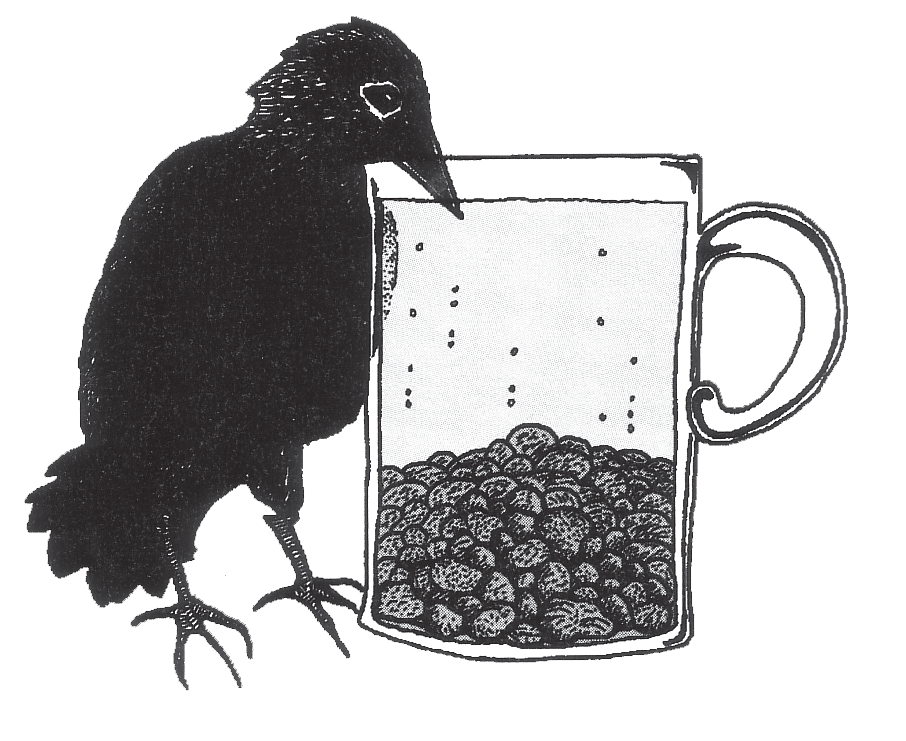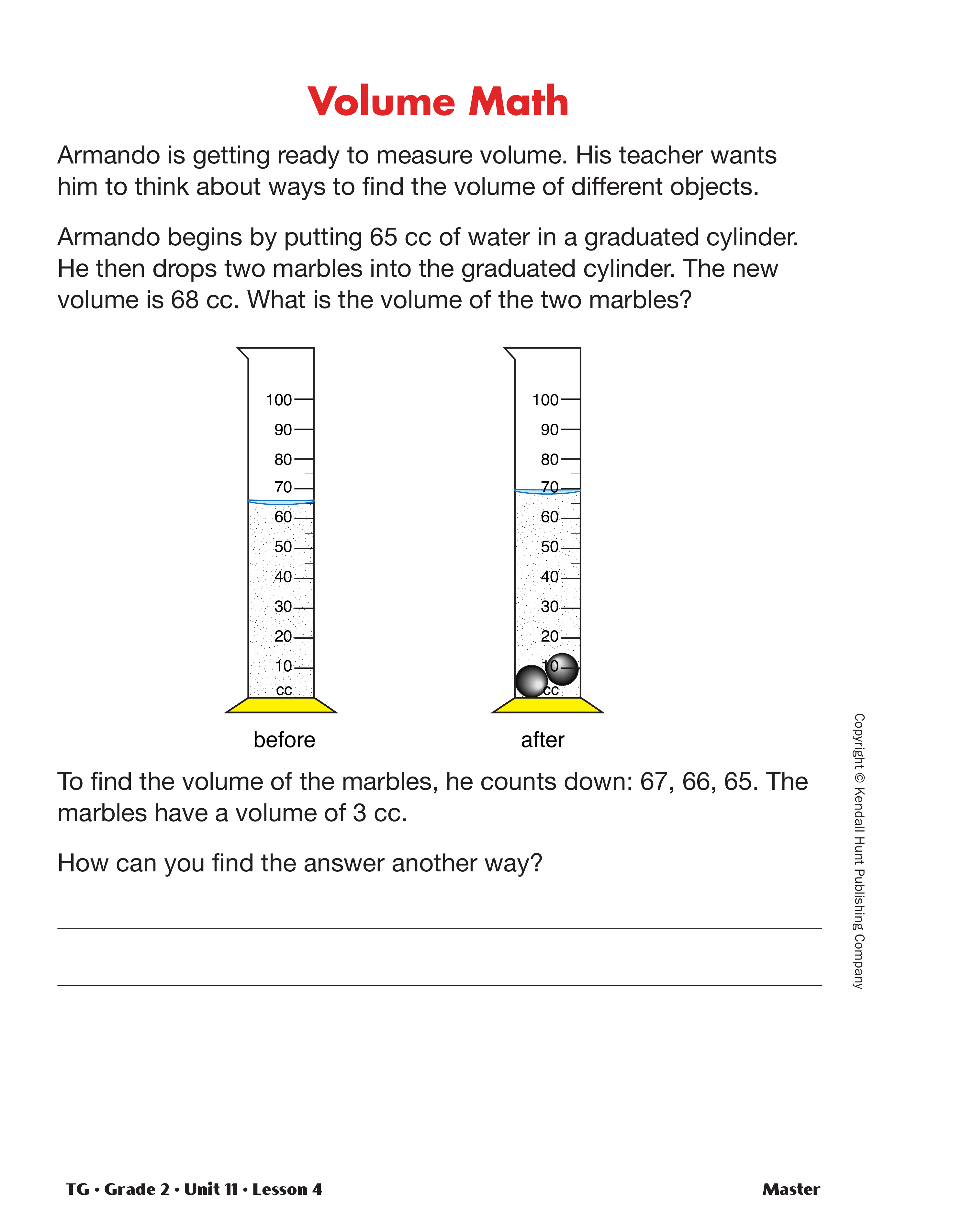Introduce Measurement by Displacement with
Story. Read the book Mr Archimedes' Bath by
Pamela Allen. When Mr. Archimedes takes a bath
with three of his friends, Kangaroo, Wombat, and
Goat, the water always overflows and makes a mess.
Mr. Archimedes is determined to find the culprit.
Using a measure and taking turns getting out, they
finally discover who it is. This book is an effective
springboard for discussion about measurement of
volume by displacement. "The Crow and the
Pitcher," one of Aesop's fables, can also be used to
illustrate the concepts of volume and displacement.

The Crow and the Pitcher. "The Crow and the Pitcher," one of
Aesop's fables can be used to illustrate the concepts of
volume and displacement. This is a very old story of a very
thirsty crow. The crow, ready to die of thirst, flew with joy to a
pitcher which he saw some distance away. When he came to
the pitcher, he found water in it, but so near the bottom that
he was not able to drink. He tried to knock over the pitcher so
he might at least get a little of the water, but he did not have
enough strength for this. At last, seeing some pebbles nearby,
he dropped them one by one into the pitcher, so little by little,
he raised the water to the very brim and satisfied his thirst.

You can ask a student to act out the part of the crow as you
tell the story. He or she can drop marbles in the container of
water to illustrate how the objects displace the water. There
are also many animated versions of the story available. You
may choose to show the animated version to better illustrate
the action of displacement described in this story.
Show students the items you collected before the lesson
and tell them that in this lab they will determine
the items' volumes. Remind students that volume is
the measure of the space occupied by an object.
Students should recall that in the lab Marshmallows
and Containers in Unit 5, they found the volume of
three containers by filling them. In Unit 10, Addition
Properties Using Volume, they found volume by
counting cubes. Hold up a train of 8 centimeter connecting
cubes as a model.
Explain that the unit of volume in the lab is a cube
that is one centimeter on each side. This unit is given
the special name 1 cubic centimeter or 1 cc.
- What is the volume of this train of connecting
cubes? How do you know? (I count the cubes.
There are 8 cubes, so it is 8 cubic centimeters.)
Remind students that a cubic centimeter is equivalent
to a milliliter, particularly if your graduated
cylinders are marked in milliliters. See the discussion
in Lesson 2 of this unit.
Hold up the set of objects you have collected and
ask:
- How can you find the volume of an object that cannot
be filled or that doesn't have cubes to count?
- How can you find out how much total space this
object takes up? Think about the story.
Connect the discussion to the books or stories you
used to open the lesson. Explain that students will
measure the volume of an object by placing it in a
graduated cylinder that contains 80 cc of water.
Show a graduated cylinder filled with 80 cc of water
and ask questions similar to the following:
- What happens to the water level in a container
when you add something to it? (It will rise.)
- What will happen to the water level when I put
something in this cylinder? (The water level will
rise.)
- How much will it go up? (By how big the object
is.)
- If the water goes up 10 cc, what does that say
about the size of the object? (It is 10 cc in size.)
- How much space does the object take up in the
water? (10 cc)
- Is that its volume? (yes)
Show the train of centimeter connecting cubes again.
- What is the volume of this train? How did you find
it? (8 cc; by counting the cubes in the train)
Show students the graduated cylinder you have filled
with 80 cc of water and the train of centimeter connecting
cubes.
- There are 80 cc of water in this cylinder. What will
happen to the water if I add this train of 8 connecting
cubes? (Possible response: The volume will
rise.)
- What volume will show on the graduated cylinder? (Possible response: 88 cc)
- How do you know? (Possible response: You
started with 80 cc and added 8 cc. The new volume
is 88 cc.)
Mass vs. Volume. Students often confuse the amount of
matter (mass) with the space occupied (volume). Students
may assume that a heavy object will occupy more space
than a light object. But if students consider a balloon
filled with air and a small steel sphere, they will see that
sometimes the lesser mass has the greater volume.
Students may suggest measuring the object to find volume.
Do not dismiss this suggestion since students will learn to
determine volume of some objects by measurement in later
grades. Rather, focus the discussion on the difficulty of
measuring the small, irregular objects you have collected,
especially since all the faces would have to be measured. In
addition, the measurement of any one face would not give
the volume.
Demonstrate Measurement by Displacement. Demonstrate finding the volume of the train of centimeter
connecting cubes using a graduated cylinder
filled with 80 cc water. Explain that objects must be
put into the graduated cylinder very carefully so that
no water will splash out. Drop the centimeter connecting
cube train gently into the cylinder or tilt the
graduated cylinder and let the cube train slide in.
The water level rises but the volume of water does
not change when the object is placed in the graduated
cylinder.
Some objects, such as the links and centimeter connecting
cubes, will float to the top. Since the object
must be submerged to get an accurate reading of volume,
students will have to push the objects under the
water to read the volume. Tell them not to push the
object under with a finger since a finger has a large
volume that will distort the reading. Instead, they
should use something with a small volume, such as a
pencil tip. Show students how to push the object
until it is just under the water.
After inserting the cube train, ask:
- Is there more water in the graduated cylinder now?
Why or why not? (No, you didn't put any more
water into it.)
- How much water is still in the cylinder? (80 cc)
- What happened to the level of the water? (It went
higher in the cylinder.)
Some students may have a tendency to read the volume of
an object as the placement of the top of the object in the
graduated cylinder after it sinks to the bottom, rather than
reading the meniscus of the water level above it. Point out
during demonstration that it is the water level that should be
read, not looking at where the top of the object "stops" in the
cylinder.
Direct students' attention to the Reading a Graduated
Cylinder Tips chart that is on display from Lesson 2.
- Can someone come read what the level says now? (It is 88 cc now.)
- What was the volume of the water before the
object was put into the graduated cylinder? (80 cc)
- What is the total volume of the water and the train
of centimeter connecting cubes? (88 cc)
- Can you think of a way to find the volume of the
connecting cube train alone? (Possible response:
We can count up from 80 to 88, or count back
from 88 to 80.)
- What number sentence shows how to find the difference
in the water level before and after I put the
train of connecting cubes into the graduated cylinder? (Possible responses: 88 − 80 = 8 cc;
80 + = 88 cc)
- What number sentence shows the sum of the
water in the graduated cylinder and the volume of
the train of centimeter connecting cubes together
or the total volume? (80 + 8 = 88 cc)
- Was your prediction correct? How do you know? (Yes, we were correct because we started with
80 cc of water and now the cylinder says 88 cc,
so the water went up 8 cc to show the volume of
the cube train.)
- The volume of this graduated cylinder is 100 cc.
How many trains of 8 connecting cubes are needed
to make a total volume greater than 100 cc?
Explain your thinking. (Possible response: One
train makes a total volume of 88 and two trains,
96 cc. Three trains add too much volume. So, the
volume of two trains and 80 cc of water is a little
less than 100 cc.)
Demonstrate how to remove the train of cubes by
emptying the water from the graduated cylinder into
a small cup. Remove the cube train and pour the
water back into the cylinder. Explain that you need
to check the water level again as it will be a little
less than 80 cc; add water with the eyedropper until
it reaches 80 cc again.
Guide students in finding the volume of an object
that is not easily predicted. Hold up the object you
selected for demonstration and place it into the graduated
cylinder. Have a student read the meniscus.
Have students talk with a partner to determine the
volume of the object, then encourage them to
explain their strategies and share a number sentence
that represents their thinking. Some students may
think of the problem as an addition situation and others
may think of a subtraction sentence for finding
the volume of the object (V). Here are two possible
solution strategies for an object with a volume of
4 cc:
- 80 + = 84 cc; volume is 4 cc because
80 + 4 = 84 cc
- 84 − 80 = 4 cc
Display the Volume Math Master. Discuss
Armando's problem and his solution path. Ask students
to share their strategies for solving the problem.
Have them write number sentences to show
their thinking.
Include prompts similar to the following:
- What is the difference in the water level before and
after Armando put the marbles into in the graduated
cylinder? What number sentence shows how
to find the difference? (3 cc; 68 − 65 = 3 cc)
- What number sentence shows the sum of the
water in the graduated cylinder and the volume of
the marbles, or the total volume? (65 + 3 = 68 cc)



















